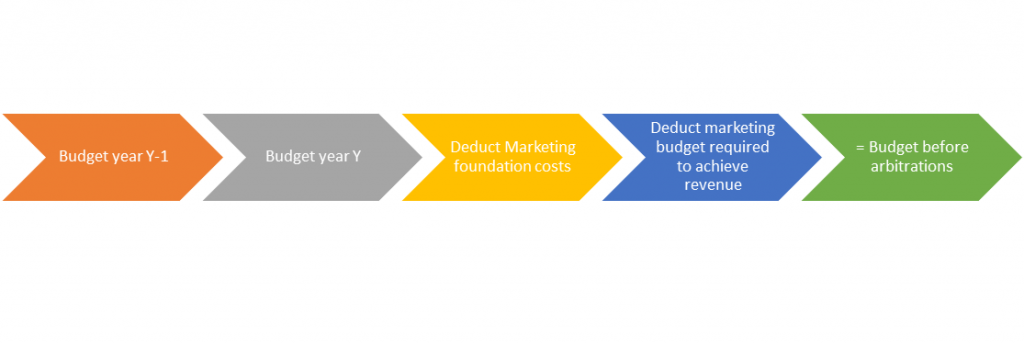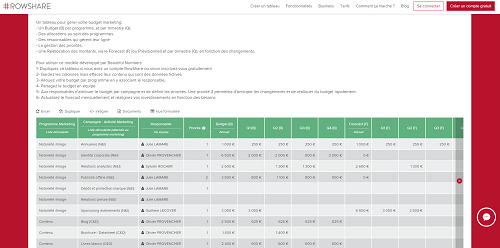When it’s time for next year B2B marketing budget, it’s not always easy to decide where to start
What should be the first step and the best approach to create my marketing budget?
Should we go for a top down approach (assuming numbers are available), or bottom up and start by defining the needs?
Should we, as advocated by marketing schools, take a % of the company’s turnover?

–
I ‘d be tempted to say « none of those », and suggest that you start with an analysis of your current marketing budget, and agree on:
How much – How & what– what for?
1 / First of all “how much was my budget” (don’t forget to include the extra amounts allocated through the year) and especially “how much did I actually spend”?
Why watch « actuals »? Because it will tell you what really happened during the year. Not what you had plan.
Then because it helps measuring the gap between what you wanted to do and what you’ve been able to achieve. It will help not repeat the same mistakes.
2/ The second step is to go into more granularity and understand how it was spent. And analyze your investments accross different dimensions.
If you benefit from the support of a Marketing Ops, you can get a full analysis of your budget. Otherwise, it may be time consuming, so better limit oneself to main dimensions.
As an example :
- Per program : Awareness, Content, Lead Generation, Customer relation, Partners relations, Marketing Fondations
- Per tactics or projects : PR, Blog/White papers, Conferences, Customer retention, Partner recruitement, Database..
- Per team : region or segment
- Per product,
- etc…
In any case, it is important to identify the amount of your “structural costs” sometimes called “Marketing Ops” or “Foundation”, which allow the marketing department to function:
- Tools and infrastructure (CRM, Marketing Automation, ..)
- Database
- Maketing Intelligence (Dashboards, data analysis and reporting)
- etc…
3 / And finally: what for?
Finally, It is imperative to understand the impact of your marketing activities on your company’s business:
Which programs generated the most leads, revenue, and reinforced your customers loyalty.
What is the cost of an opportunity, what are your conversion rates? …
So the loop is closed, you have a clear picture of how much you’ve spent, what activities you’ve invested in, and what was there impact. You have all the information to start elaborating your new budget.
–
LET’S GO !
If the amount of your new budget is available when preparing your allocation, you are among the lucky ones (or latecomers :-). If not, use your actual expenses as a basis. In most cases, your Finance departement has already worked on a Marketing forecast based on you have spent and not on what you were allocated.

A best practice is to set plan A with a marketing budget up to 100% of this amount, and a plan B up to 85%. Yes, it is a bit constraining but it has two big advantages
- Be agile in case of a smaller Finance budget allocation.
- Immediately see what is not priority (since not present in the plan at 85%).
In both cases, deduct the structural costs mentioned above.
–
This new amount will serve as a starting point for your budget elaboration.
B2B marketing budgets are set up by objectives, so you will have to get them from your CEO or CMO, and ask Sales to confirm their sales targets. With this information in hand, it is now necessary to set the marketing objectives.
To align with the revenues target, we can proceed with the following method allowing you to start from the expected revenues to define the contacts # required to obtain it.
Example for the company John Doe:
- It is established that for a turnover of 1000 €, the company must benefit from a pipe of 2500 €
- It is also established that 20% of these 2500 € come from marketing, = a marketing objective of 500 €.
- Considering these 500 € are made up 100% by selling products A, whose average selling price = 10 € ==> Marketing will have to provide 50 opportunities.
- If you do not know the cost of an opportunity, you can then use your conversion rates, and go back from opportunities # to qualified leads # and from leads to contacts.
Since now you know how much cost a contact, you know the budget needed to achieve your objectives.
Obviously, in case of multiple countries, products, etc., your spreadsheet will be your best friend – or your Marketing Ops! This second amount will allow you to initiate discussions with stakeholders.
This second amount will allow you to initiate discussions with stakeholders.
Many arbitrations will then have to be decided in order to finalize your budget allocation:
–
- Is this amount fitting in my total as defined in plan A or B ?
- What budget for activities that are not directly measurable?Which channels to use?
- What medium- or short-term goals?
- Should a particular event (product launch, business buy-out) be taken into account?

–
Do not forget to ensure a sensible distribution of the budget by marketing managers. Quickly checking the amount allocated per person is a good indicator of a unbalanced organisation and potential bottle necks.
–
If it is often difficult to solve the equation « budget = achievement of objectives », it will be easier to negotiate a budget extension or alignment of objectives when having reliable information.
The steps mentioned so far will facilitate this.
And then ?
PILOT YOUR BUDGET!
Once the budget has been finalized, make sure you do not over or under spend : identify relevant indicators, set target values, (50% of the budget must be commited by ddmmyy), use intelligent- easy-to-use collaborative tools, and identify action levers.
Check as well that it is used as per the plan.
If you do not know where to start, an quick win is to track your expenses collaboratively. You will be able to respond to urgent requests, launch unexpected campaigns or stop an operation that does not reach its objectives. And always be in control !
To help you, you can use RowShare with whom I collaborated to create a free collaborative B2B marketing budget template:
Or put in place your own budgetary process !
Putting in place a budgetary monitoring process is a tricky project.
It involves changes in the marketing culture and in its organization.
But above all, it is a story of men, motivation, involvement and ambition.
Overloading teams with Excel files, or complex processes, is only a source of demotivation.
Good budget to all!


